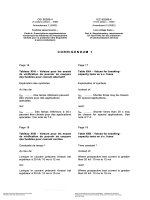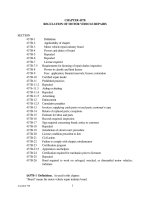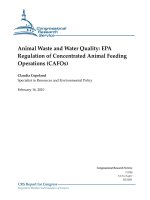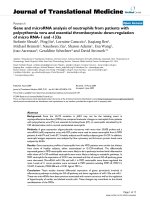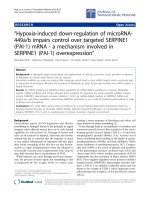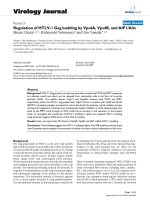Regulation of S Phase
Bạn đang xem bản rút gọn của tài liệu. Xem và tải ngay bản đầy đủ của tài liệu tại đây (416.95 KB, 33 trang )
Results Probl Cell Differ (42)
P. Kaldis: Cell Cycle Regulation
DOI 10.1007/b137221/Published online: 6 July 2005
© Springer-Verlag Berlin Heidelberg 2005
Regulation of S Phase
Jamie K. Teer
1,2
· Anindya Dutta
1,2
(✉)
1
Biological and Biomedical Sciences Program, Harvard Medical School,
Boston, MA 02115, USA
2
Dept. Of Biochemistry, University of Virginia, Charlottesville, VA 22908, USA
Abstract Regulation of DNA replication is critical for accurate and timely dissemination
of genomic material to daughter cells. The cell uses a variety of mechanisms to control
this aspect of the cell cycle. There are various determinants of origin identification, as
well as a large number of proteins required to load replication complexes at these defined
genomic regions. A pre-Replication Complex (pre-RC) associates with origins in the G1
phase. This complex includes the Origin Recognition Complex (ORC), which serves to
recognize origins, the putative helicase MCM2-7, and other factors important for com-
plex assembly. Following pre-RC loading, a pre-Initiation Complex (pre-IC) builds upon
the helicase with factors required for eventual loading of replicative polymerases. The
chromatin association of these two complexes is temporally distinct, with pre-RC being
inhibited, and pre-IC being activated by cyclin-dependent kinases (Cdks). This regulation
is the basis for replication licensing, which allows replication to occur at a specific time
once, and only once, per cell cycle. By preventing extra rounds of replication within a cell
cycle, or by ensuring the cell cycle cannot progress until the environmental and intracel-
lular conditions are most optimal, cells are able to carry out a successful replication cycle
with minimal mutations.
1
Introduction
DNA replication is fundamentally critical, and yet rather problematic for all
life. Cells must be prepared to replicate the entire genome, and must do so
in a concerted, rapid, and efficient fashion. Failures in this process not only
yield potentially damaging mutations, but may also hinder proper genome
segregation between offspring. This problem becomes even more pronounced
with increasing size of a given genome. Cells have a variety of mechanisms
to ensure that the proper environment exists to carry out replication. These
mechanisms can be divided into proper identification of appropriate origins
of replication, and subsequent loading of the replication machinery itself. We
will focus our discussion on the initiation of replication in eukaryotes, and
how it can be used by the cells to control S-phase progression.
32 J.K. Teer · A. Dutta
2
Origins of Replication
2.1
Genome Replicator Sequences
Theoretically, replication would be carried out most efficiently by starting
from many different evenly spaced sites. Such a model might assume, how-
ever, that specific, conserved origins of replication exist. Studies on origins in
various systems support the early theory of a replicator sequence that marks
the origin of replication, and an initiator protein that binds this sequence and
recruits downstream factors required for replication (Jacob et al., 1963). The
earliest eukaryotic replicator was found in Saccharomyces cerevisiae,andwas
named ARS for autonomously replicating sequence (Stinchcomb et al., 1979;
Struhl et al., 1979). Study of the ARS1 locus in budding yeast revealed con-
served sequence blocks that were essential for replication, including an 11 bp
consensus seqeunce (A element) and several other B elements (Marahrens
and Stillman, 1992). These replicator sequences were used later to identify the
putative initiator proteins: the Origin Recognition Complex [ORC] (see be-
low). In Schizosaccharomyces pombe, two 30-55 base pair elements essential
for replication were discovered in origin ars3002, and similar sequences were
found in other ars regions (Dubey et al., 1996). Although the yeasts seem to
have high sequence conservation from one replicator to the next, determining
such consensus replicators in higher eukaryotes has been more difficult.
Studies in Xenopus laevis egg extracts have not identified a consensus
replicator sequence. On the contrary, early results indicate the lack of se-
quence specificity in replicating regions (Hyrien and Mechali, 1992; Hyrien
and Mechali, 1993; Mahbubani et al., 1992). Recent studies show that while
the ORC proteins may prefer AT rich DNA stretches, they show no preference
between defined origin sequences and control sequences in vitro, even with
varying ORC concentration (Vashee et al., 2003). Such random origin selec-
tion may, however, be a function of the early embryogensis system. When ori-
gin selection in the rDNA locus was studied at different times in development,
increasing origin specificity was seen as development progressed (Hyrien
et al., 1995). In early stages, origin selection was random, but when rDNA
gene expression began in late blastula and early gastrula stages, initiation
frequency decreased in the transcribed regions. This effectively limited ini-
tiation to the intergenic regions. Similar results were observed in Drosophila
embryos (Sasaki et al., 1999). Interestingly, when intact mammalian nuclei
were added to Xenopus extracts, they initiated replication at specific sites.
Disrupting the nuclei before incubation ablated this specificity (Gilbert et al.,
1995). Additionally, intact mammalian nuclei isolated before a certain time in
the G1 phase also failed to initiate specifically (Wu and Gilbert, 1996). Taken
Regulation of S Phase 33
together, these results indicate that metazoans do seem to initiate replication
at specific sites, but this specificity may be determined not by sequence, but
by other influences from local chromatin and nuclear environments.
The picture is also complicated in mammalian systems. Early work in
chinese hamster ovary cells revealed a replication origin in the dihydrofo-
late reductase (DHFR) locus (Heintz and Hamlin, 1982; Heintz et al., 1983).
Although this origin firing was originally thought to be highly sequence spe-
cific, later two dimensional gel electrophoresis showed that origins fire in
a broad zone (55 kb) throughout the intergenic region [but not in the DHFR
gene itself] (Dijkwel and Hamlin, 1995; Vaughn et al., 1990). These observa-
tions argue against a defined sequence specificity. A different study, however,
used nascent strand abundance assays on the same DHFR region to demon-
strate only two to three major initiation sites, again raising the possibility of
sequence specificity (Burhans et al., 1990; Kobayashi et al., 1998). Recently,
a study using early labeled fragment hybridization (ELFH) showed that the
earliest nascent strands could hybridize to many clones from different areas
along the intergenic region, suggesting that replication can be initiated from
many different sites (Dijkwel et al., 2002). Additionally, a deletion mapping
experiment showed that replication could initiate from the intergenic region
in the absence of the major sites, and even in the absence of 90%oftheregion
(Mesner et al., 2003). These studies indicate the regions of potential origin fir-
ing in higher eukaryotes may not be determined simply by sequence, but by
other factors.
Like Chinese hamster cells, few origins of replication are known in human
cells. One of the earlier defined origins of replication is at the β-globin lo-
cus. A bidirectional origin was found to exist in the 2 kb region between the
δ and β globin genes, and deleting this region abrogated the bidirectional ac-
tivity (Kitsberg et al., 1993). This result suggested a sequence element may be
present in this region to direct origin firing. Furthermore, an ectopically in-
serted β-globin locus promoted initiation at the ectopic site (Aladjem et al.,
1998). Deletion mapping of the β-globin locus showed several sequences crit-
ical for replication initiation at the locus, in both ectopic and native locations
(Aladjem et al., 1998; Wang et al., 2004). Similar results have been observed
at the lamin B2 locus [1.2 kb] (Paixao et al., 2004), the hamster DHFR lo-
cus [5.8 kb] (Altman and Fanning, 2004), and the c-myc locus [2.4 kb] (Liu
et al., 2003): ectopically inserted sequences can confer origin activity, and
deletion of specific elements eliminates such activity. Unfortunately, the se-
quence elements do not seem to be identical, and no consensus sequences
have emerged. There does seem to be an important role of AT rich sequences,
as these are often found in critical deleted regions. Supporting this idea, an
essential AT rich element in the lamin B2 locus can substitute for the AT-
rich element in hamster ori-β locus (Altman and Fanning, 2004). One should
note that experiments showing sequence specificity generally measure origin
firing by PCR of nascent strands, while studies supporting sequence inde-
34 J.K. Teer · A. Dutta
pendent origin firing use ELFH and two dimensional gel electrophoresis. The
possibility exists that different methodologies may have different effects on
the results.
In addition to sequence effects, many studies have implicated transcrip-
tion in selection of replication origins. In the DHFR locus, transcription of
DHFR itself is required for origin firing activity, and yet origins do not fire in
the gene (Kalejta et al., 1998; Saha et al., 2004). In yeast, evidence exists for
transcriptional correlation with replication (Muller et al., 2000), but this may
be limited to few specific sites, as a genomic microarray study failed to see
a good correlation (Raghuraman et al., 2001). Many studies have shown a link
between early origin firing and transcriptional activity by looking at replica-
tion of developmentally regulated genes, as well as genes from asymmetrically
active alleles [reviewed in (Goren and Cedar, 2003)]. In the latter case, the
active alleles are replicated much earlier than the silenced alleles. Addition-
ally, replication studies using human (Jeon et al., 2005; Woodfine et al., 2004)
and Drosophila (Macalpine et al., 2004; Schubeler et al., 2002) genome tiling
microarrays show a positive correlation between early origin activity, gene
density, and transcriptional activity. Recent results in Drosophila indicate that
histone hyperacetylation is important for ORC recruitment, although induced
hyperacetylation did not affect transcription (Aggarwal and Calvi, 2004).
These studies indicate that, in higher eukaryotes, an environment generated
by transcription allows for efficient origin firing. One might imagine that the
open chromatin environment for transcription would also benefit replication,
linking the two different activities.
Although controversy exists as to whether higher eukaryotic origins are
sequence dependent or not, the complexity of these organisms may allow a re-
ality that lies somewhere in the middle. In budding yeast, sequence specificity
in the form of well established consensus replicators seems to be the primary
determinant of origin locations. However, as organism complexity increases,
so does the complexity of origin determination. In metazoans, a consensus
origin sequence has not yet been identified. Many reports show that certain
sequence elements are important for firing, but that these elements for the
most part do not share common primary sequence, or even overall features,
aside from AT rich sequence preference. Initiator proteins show no prefer-
ence for sequence, but may show some preference instead for structure [to
be discussed later] (Remus et al., 2004), indicating that these essential elem-
ents exist to provide a favorable environment for initiator loading. Other
factors may also affect chromatin structure, especially during transcription.
The positive correlation between origin firing and transcriptional activity in
higher eukaryotes suggests that the more open chromatin structure not only
allows efficient transcription, but efficient replication initiation as well. It is
also plausible that different origins may have differential influences on their
activity. Nearby transcriptional activity may be important for one origin,
whereas critical sequence elements are important for another. In summary,
Regulation of S Phase 35
origin selection in eukaryotes is defined by the proper environment for ini-
tiator binding, whether defined solely by DNA sequence elements, structural
elements, chromatin structure itself, or a combination of effects. Thus, the
early theory of a replicator still holds true today. The increasing complexity
of higher eukaryotes simply means that the defining elements of a replicator
are themselves more multifaceted.
3
Pre-Replication Complex
3.1
ORC
The identification of replicator sequences in S. cerevisiae opened the field of
DNA replication in eukaryotes. One of the first critical discoveries stemming
from this work was the identification of the proposed initiator proteins. The
consensus A element of the ARS sequence was used to identify a six subunit
complex termed ORC, or Origin Recognition Complex (Bell and Stillman,
1992). Mutations in the A element that prevent ORC binding also prevent
replication from the mutated ARS, (Bell and Stillman, 1992; Rowley et al.,
1995) supporting the idea that budding yeast ORC is the protein initiator
responsible for recognizing specific replicator sequences. ORC is highly con-
served, with homologues identified in A.thaliana,S.pombe, D. melanogaster,
X. laevis, M. musculus, H. sapiens, and others (Carpenter et al., 1996; Dhar
and Dutta, 2000; Gavin et al., 1995; Gossen et al., 1995; Leatherwood et al.,
1996; Masuda et al., 2004; Muzi-Falconi and Kelly, 1995; Pinto et al., 1999;
Quintana et al., 1997; Quintana et al., 1998; Tugal et al., 1998). The ORC
subunits have been shown to form a functional complex in D. melanogaster
(Chesnokov et al., 1999), S. pombe (Moon et al., 1999), X. laevis (Gillespie
et al., 2001), and H. sapiens (Dhar et al., 2001a; Vashee et al., 2001).
As a replicative initiator, ORC should be able to recognize the replicator
sequences. ORC has been shown by many to bind DNA, and this binding is
dependent on ATP and the ATP binding functions of ORC (Bell and Still-
man, 1992; Chesnokov et al., 2001; Gillespie et al., 2001; Seki and Diffley,
2000). Specific replicator sequence association has been observed in S. cere-
visiae and S. pombe. Work in the latter organism has revealed that Orc4
dictates the specificity via a newly defined AT hook region (Kong and De-
Pamphilis, 2001; Lee et al., 2001). ORC from higher eukaryotes, however, does
not seem to have the same sequence specificity. Drosophila ORC showed lit-
tle preference for chorion gene sequences compared to controls, but showed
a much better preference for negative supercoiled DNA compared to relaxed
or linear, suggesting secondary structure is more important than sequence for
36 J.K. Teer · A. Dutta
initiator/replicator interactions in metazoans (Remus et al., 2004). Similarly,
human ORC shows no preference for known origins compared to random
DNA sequences, but does show a slight preference for AT rich DNA (Vashee
et al., 2003). While ORC may be responsible for DNA binding, the mechan-
ism of such binding becomes unclear with increasing organism complexity,
perhaps due to the increasing complexity of factors affecting origin selection.
Although the intricacies of the ORC-DNA interaction are not fully un-
derstood, the general role of ORC in replication is now accepted. Studies in
Xenopus egg extracts have demonstrated that ORC is required to load Cdt1
and Cdc6, themselves factors required for replication initiation [discussed
further below] (Coleman et al., 1996; Maiorano et al., 2000). This dependence
of replication factor recruitment on ORC helps to explain the lethality of all
ORC subunit deletions in yeast. As the foundation of replication initiation
complexes, the role of ORC seems to be critical for downstream functions.
As ORC is a key player in defining and recruiting a replication complex
to an origin, it is an important potential target for controlling replication.
In yeasts, the ORC remains bound to chromatin throughout the cell cycle.
However, in S. cerevisiae, Orc2 and Orc6 are phosphorylated by S-phase
cyclin/Cdk1 during the G1/S transition. This ORC phosphorylation was
found to be part of a mechanism to limit origin firing activity to only once
per cell cycle; when Orc2 and Orc6 phosphorylation site mutants were intro-
duced with constitutively active Cdc6 and MCM proteins (see Sects. 3.3 and
3.4, respectively), rereplication was observed (Nguyen et al., 2001; Wilmes
et al., 2004). Similarly, S. pombe Orc2 is phosphorylated, which may be due
to its similar interaction with Cdk1/cyclin B in the G2 phase. This interaction
serves to prevent rereplication without an intervening mitosis, again ensur-
ing only one replication event per cell cycle takes place (Wuarin et al., 2002).
Phosphorylation is well studied as a molecular switch to regulate protein ac-
tivity through a variety of mechanisms and ORC phosphorylation gives the
cells a reversible way to prevent replication firing.
In higher eukaryotes, phosphorylation of ORC subunits is also observed.
In Xenopus systems, phosphorylation of ORC by cyclin A dependent kinase
activity disrupts ORC chromatin association (Findeisen et al., 1999). Simi-
larly, mammalian Orc1 is phosphorylated. In Chinese hamster ovary cells,
Orc1 interacts with cyclin A/Cdk1, which leads to the phosphorylation of
Orc1. Inhibiting this phosphorylation with drugs allows Orc1 to rebind chro-
matin, indicating that phosphorylation is important for chromatin release in
mitosis (Li et al., 2004). In human cells, Orc1 is also phosphorylated in vivo
(our unpublished results) and in vitro by cyclin A/Cdk2 (Mendez et al., 2002).
This phosphorylation seems to be required for Skp2 mediated ubiquitination
of Orc1 (Mendez et al., 2002). Similarly, hamster Orc1 is also ubiquitinated.
However, the nature and effect of these ubiquitination events is different. In
hamster cells, Orc1 seems to be mono- and di-ubiquitinated, which causes its
release from chromatin in S-phase until M-G1 (Li and DePamphilis, 2002).
Regulation of S Phase 37
In humans, several studies show that Orc1 is polyubiquitinated and then de-
graded by the proteasome during S-phase, (Fujita et al., 2002; Mendez et al.,
2002; Tatsumi et al., 2003) although this observation may result from proteol-
ysis after lysis (Ritzi et al., 2003). Although not degraded during the cell cycle,
hamster Orc1 is increasingly sensitive to proteasomal degradation when ar-
tificially released to the cytoplasm (Li and DePamphilis, 2002). In Drosophila
embryos, Orc1 is degraded in M and early G1 phases by the APC/fzr complex
(Araki et al., 2003). Despite the apparent contradictions, which may simply
result from differences between organisms or even cell types, Orc1 binding to
chromatin can be regulated in higher eukaryotes. This regulation allows the
cells to control replication initiation at the basic level of the ORC, ensuring
inappropriate replication initiation has little, if any, chance of success.
3.2
Cdt1
Cdt1 was first identified as a Cdc10 regulated gene in S. pombe.Thisgenewas
found to be cell cycle regulated, and important for replication (Hofmann and
Beach, 1994). It associates with Cdc6 and is required for loading of the MCM
complex in several model systems (Maiorano et al., 2000; Nishitani et al.,
2000; Tanaka and Diffley, 2002). Its own chromatin loading is dependent on
ORC (Maiorano et al., 2000), supporting the idea that ORC serves as a foun-
dation that recruits downstream factors for replication. Cdt1 protein itself is
regulated during the cell cycle, not by transcription, but by proteasome de-
pendent degradation in S-phase (Hofmann and Beach, 1994; Nishitani et al.,
2001). A study in C. elegans implicated the ubiquitin ligase Cul-4 in Cdt1
degradation; when Cul-4 is absent, Cdt1 is stabilized in S-phase, and mas-
sive re-replication is observed (Zhong et al., 2003). In humans, the SCF
Skp2
complex is implicated in the destruction of Cdt1, and is dependent upon
phosphorylation by cyclin-dependent kinases [Cdks] (Li et al., 2003b; Sugi-
moto et al., 2004), although mutations in Cdt1 that disrupt association with
Skp2 still permit degradation of Cdt1 in S-phase (Takeda et al., 2005). Re-
cent work in Xenopus egg extracts indicates that the degradation of Cdt1
after replication initiation, together with its inhibition by the protein gemi-
nin (discussed later), limit replication to a single round per cell cycle (Arias
and Walter, 2004; Li and Blow, 2004). As Cdt1 is required for pre-RC loading,
its inhibition by either geminin interaction or degradation will help prevent
further pre-RC formation, and thus, further replication initiation. Consistent
with this, overexpression of Cdt1 alone leads to extensive re-replication in
human cells (Vaziri et al., 2003).
In addition to its function as a replication licensing factor, Cdt1 has re-
cently been implicated in preventing replication initiation after DNA damage
in human cells. Cdt1 levels were found to be profoundly decreased after UV
irradiation, and an E3 ligase, Cul4A-Roc1-Ddb1, was responsible for signaling
38 J.K. Teer · A. Dutta
this degradation via the proteasome (Higa et al., 2003; Hu et al., 2004). In-
terestingly, a separate study implicated the SCF
Skp2
complex in the radiation
induced degradation of Cdt1 (Kondo et al., 2004). It remains to be resolved
which ubiquitin ligase is primarily responsible for both the cell cycle depen-
dent modifications and the DNA damage induced modifications.
3.3
Cdc6
Cdc6 was originally identified in S. cerevisiae as a protein essential for cell
cycle progression (Hartwell et al., 1974), and was thereafter shown to have an
early DNA synthesis defect (Hartwell, 1976). Cdc6 interacts with ORC, form-
ing a complex with an extended nuclease protected DNA footprint (Cocker
et al., 1996; Liang et al., 1995). Furthermore, Cdc6 expression is required for
MCM loading in budding yeast. Interestingly, phosphorylation of Cdc6 by B-
type cyclin/Cdk complexes prevented the loading of Cdc6, illustrating a pow-
erful way for the cells to regulate pre-RC formation (Donovan et al., 1997;
Tanaka et al., 1997). By phosphorylating Cdc6 in S and G2/M, its activity was
limited, preventing inappropriate origin firing in mitosis. ScCdc6 was also
found to be marked for degradation at the G1/S transition by Clb/Cdc28 and
the Cdc4/Cdc34/Cdc53 ubiquitination machinery, adding a further layer of
regulation (Drury et al., 1997; Elsasser et al., 1999). A similar gene, Cdc18, was
identified in S. pombe, and is also required for S-phase. Indeed, its overex-
pression in S. pombe resulted in severe rereplication. Additionally, its protein
levels cycle, with maximum levels present during the G1/S transition (Muzi-
Falconi et al., 1996; Nishitani and Nurse, 1995). Cdc18 is phosphorylated upon
entry into S-phase, causing its rapid degradation (Jallepalli et al., 1997). Not
only is Cdc18 required for MCM binding, but it seems to promote this binding
in anaphase, supporting the idea that pre-RCs are formed in mitosis (Kearsey
et al., 2000). Cdc18 and Cdc6 were later shown to be homologues.
Cdc6 is found in higher eukaryotes as well. Homologues have been identi-
fied in Xenopus, humans and others (Coleman et al., 1996; Saha et al., 1998;
Williams et al., 1997). Using the Xenopus egg extract system, it was found
that Cdc6 binding to chromatin is dependent on ORC, and is required for
MCM2-7 loading, thus implicating a sequential assembly of pre-RC compo-
nents (Coleman et al., 1996). Similar results were observed in a human cell
free extract (Stoeber et al., 1998). Human Cdc6 is partially cell cycle regulated;
it is under the control of the E2F transcription factor, which is responsible for
promoting expression of numerous genes required for proliferation (Ohtani
et al., 1998; Yan et al., 1998). However, unlike yeasts, human Cdc6 may not
be degraded at the G1/S transition, but has been found to be exported from
the nucleus in a phosphorylation dependent manner (Delmolino et al., 2001;
Fujita et al., 1999; Jiang et al., 1999; Saha et al., 1998). This phosphoryla-
tion is controlled by cyclin A/Cdk2, which allows for export of Cdc6 soon
Regulation of S Phase 39
after replication has initiated (Petersen et al., 1999). Some evidence exists that
human Cdc6 is degraded in Sphase, just as in yeast, a point that will need
resolution (Coverley et al., 2000; Mendez and Stillman, 2000). Recently it was
also reported that although exogenous Cdc6 is exported from the nucleus in
S-phase, endogenous Cdc6 is not (Alexandrow and Hamlin, 2004). One fur-
ther study demonstrates that although Cdc6 is released from chromatin and
then degraded, it is constantly being resynthesized and immediately binds
chromatin, replacing molecules which were displaced (Biermann et al., 2002).
This observation may reconcile earlier observed differences, allowing Cdc6 to
bind chromatin in S-phase in a tenuous manner so that rapid regulation can
be achieved when needed.
Cdc6 is a AAA+ ATPase as is its homolog Orc1 (Neuwald et al., 1999), and
is therefore also regulated in cis. The recently solved structure of an archaeal
Cdc6 ortholog confirms the presence of a AAA+ ATPase domain, contain-
ing Walker A and B motifs, and well as several sensor regions thought to
detect nucleotide binding status (Liu et al., 2000). Several studies have been
carried out to characterize the importance of its ATP binding and hydrolysis
activities. From these studies, it appears that the Walker A motif (nucleotide
binding) may be important for Cdc6 binding to chromatin, and Walker B mo-
tif (nucleotide hydrolysis) is involved in MCM2-7 loading (Herbig et al., 1999;
Perkins and Diffley, 1998; Weinreich et al., 1999). In addition to replication
defects caused by mutation in the Walker A and B regions, certain mutations
in the sensor regions are also detrimental to replication, often by failing to
recruit MCM (Schepers and Diffley, 2001). These studies indicate the ATP
binding and hydrolysis of Cdc6 are critical to its function in many different
organisms.
In addition to its direct regulation, which serves to limit replication to
once, and only once per cell cycle by controlling MCM loading, Cdc6 also
has several other secondary roles. Interestingly, Cdc6 seems to regulate ORC
by inhibiting its non-specific DNA binding (Harvey and Newport, 2003;
Mizushima et al., 2000). By increasing sequence specificity of ORC, Cdc6 may
be playing an indirect role in origin selection, especially in higher eukary-
otes where consensus initiators have been elusive. This function may also help
prevent inefficient fork firing by ensuring ORCs are directed to specific sites,
presumably spaced evenly along the chromosome.
Cdc6 is not only regulated by the cell-cycle; it is also cleaved or degraded
during apoptosis (Blanchard et al., 2002; Pelizon et al., 2002). It is not entirely
clear why Cdc6 would be a target for apoptotic machinery; the cell no longer
needs to worry about proper replication, as it is dying. However, this loss of
Cdc6 may be part of the programmed cell death, halting replication initiation
in preparation for DNA fragmentation. This intriguing finding illustrates the
importance of Cdc6 in replication, and thus, the advantage of being able to
tightly regulate its function in pre-RC formation.
40 J.K. Teer · A. Dutta
3.4
MCM2-7
The MCM (mini chromosome maintenance) genes were originally identified
in several independent screens as mutants having cell cycle defects, or mini-
chromosome perpetuation defects [reviewed in (Dutta and Bell, 1997)]. These
proteins were found to be the complex in Xenopus responsible for licensing,
a regulatory activity that allows cells to replicate in S-phase, and not again
until an intervening mitosis occurs (Chong et al., 1995; Kubota et al., 1997;
Madine et al., 1995; Thommes et al., 1997). As mentioned earlier, MCM2-7
complex requires the chromatin loading of Cdt1 and Cdc6 (and thus, ORC)
for its own chromatin loading. Although MCM2-7 binding depends on ORC,
Cdc6, and Cdt1, once the complex is loaded onto chromatin, ORC and Cdc6
are no longer required for DNA replication. This suggests ORC and Cdc6 act
to load MCM2-7, but not to maintain this chromatin association (Hua and
Newport, 1998; Rowles et al., 1999).
The chromatin loading of MCM2-7 is regulated in a complex and redun-
dant manner. Its additional role as the replication licensing factor illustrates
its importance to replication as a whole. As such, its function has long been
an intriguing mystery. MCM2-7 seemed to colocalize with DNA polymerase ε
using ChIP (Aparicio et al., 1997; Zou and Stillman, 2000) and is critical
for replication elongation in vivo (Labib et al., 2000). Early bioinformatics
analysis suggested the MCMs may be involved in strand opening (Koonin,
1993). Biochemical analysis of the proteins confirmed this. The mammalian
MCM4,6,7 complex was purified, and this complex was found to have a mod-
erate helicase (DNA unwinding) activity (Ishimi, 1997; You et al., 1999). The
fission yeast MCM4,6,7 complex also has helicase activity (Lee and Hurwitz,
2000). Interestingly, when MCM2 or MCM3,5 were present in the complex,
helicase activity was lost (Lee and Hurwitz, 2000; Sato et al., 2000; You et al.,
1999). An archaeal MCM protein has been identified, and also has a helicase
activity (Chong et al., 2000; Kelman et al., 1999; Shechter et al., 2000). Electron
microscopy studies of the MCM complex indicate that they form a heterohex-
amer ring structure (Adachi et al., 1997; Sato et al., 2000). This is supported by
a recent report which proposes double head-to-head hexamers from a crys-
tal structure of an archaeal MCM (Fletcher et al., 2003). This structure shares
similar features with that of T-antigen, suggesting a common function to un-
wind double strand DNA (Li et al., 2003a) Despite the inhibitory nature of
MCM2, 3, and 5, they, like MCM4,6,7, are essential in yeasts [for review see
(Dutta and Bell, 1997; Kelly and Brown, 2000)]. This puzzling result seems
to indicate that MCM4,6,7 serves as the catalytic helicase domain, while the
other subunits act to modulate MCM activity. The exact mechanism of such
regulation is still unknown.
Like certain ORC subunits and Cdc6, each member of the MCM2-7 com-
plex has ATPase activity. This ATPase activity is critical for viability; mutants
Regulation of S Phase 41
in the Walker A domains show S-phase defects and cell cycle arrest (Schwacha
and Bell, 2001). Biochemical analysis of MCM helicase activity showed that
the ATPase activity of these proteins is required for the helicase activity
(Ishimi, 1997; Lee and Hurwitz, 2000; You et al., 1999). These studies indicated
that the helicase activity of these proteins is most likely the in vivo func-
tion required for replication. Interestingly, Walker A mutations in MCM4,6,7
are much more toxic to yeast than similar mutations in MCM2,3,5. Although
MCM2,3,5 are actually inhibitory for helicase activity (as described above),
they are required for optimal ATPase activity of the complex (Schwacha and
Bell, 2001). This further supports the role of the MCM4,6,7 complex as the
catalytic domain, and MCM2,3,5 serving a regulatory function.
The chromatin association of MCM2-7 is regulated by several other
methods to control replication. In budding yeast, MCM2-7 is exported from
the nucleus beginning in S-phase (Labib et al., 1999; Nguyen et al., 2000).
In higher eukaryotes, this behavior has not been described. However, Xeno-
pus egg extract MCMs dissociate from the chromatin as S-phase progresses
(Kubota et al., 1997; Thommes et al., 1997). In humans, MCMs also seem to
dissociate during S-phase, and reassociate in late G2/M-early G1 (Mendez
and Stillman, 2000). This dissociation could be a critical step to prevent re-
replication. Once MCM complex is removed, it cannot reassociate until an
intervening mitosis occurs (Seki and Diffley, 2000). This aspect of MCM reg-
ulation led it to be thought of as the critical factor necessary for chromatin
licensing. Once it is removed from chromatin, it requires the activity of ORC,
Cdc6 and Cdt1 to be reloaded. However, these proteins are unable to reload
MCM in S-phase; they are held inactive by Cdk activity through various
mechanisms described above. Therefore, in order to reload MCM, a period of
low Cdk activity must be reached (in G1) to activate these proteins, allowing
them to reload the MCM2-7 complex.
3.5
Geminin
Geminin is a small protein originally identified in a search for proteins
degraded by mitotic Xenopus egg extracts (McGarry and Kirschner, 1998).
Characterization of this protein indicated it was cell cycle regulated, with
maximum expression occurring in S/G2, followed by degradation in mitosis.
Contrary to other replication factors discussed here, geminin inhibits repli-
cation by preventing loading of MCM2-7 complex. It was subsequently deter-
mined that geminin binds Cdt1, thus inhibiting replication. This inhibition
was rescued by the addition of excess Cdt1 (Tada et al., 2001; Wohlschlegel
et al., 2000). In vitro evidence demonstrates that geminin binding to Cdt1 may
disrupt an interaction between Cdt1 and MCM6 (Yanagi et al., 2002). The dis-
ruption of MCM6 binding may be preventing the recruitment of the MCM2-7
complex. Additionally, the same study suggested that Cdt1 can bind DNA,
42 J.K. Teer · A. Dutta
and this interaction was also disrupted by geminin inhibition. A more re-
cent study suggests that a Cdt1 binding activity to MCM2 and to Cdc6 is also
inhibited by geminin binding (Cook et al., 2004). Structural studies indicate
that geminin forms a coiled-coil dimer which, together with an N-terminal
flexible portion, executes a bipartite interaction with Cdt1 (Lee et al., 2004;
Saxena et al., 2004). Initiation inhibition by geminin is now thought to be
a part of the replication licensing system that prevents multiple rounds of
replication in Xenopus egg extracts (Arias and Walter, 2004; Li and Blow,
2004). Although Cdt1 is the primary target of regulation, geminin provides
an additional pathway to inactivate Cdt1, and thus preventing inappropri-
ate replication. In mammalian systems, overexpression of Cdt1 or depletion
of geminin is sufficient to cause massive rereplication and checkpoint acti-
vation (Melixetian et al., 2004; Zhu et al., 2004). Abrogating this checkpoint
causes mitotic distress and eventual cell death, demonstrating the importance
of limiting replication to a single event per cell cycle.
3.6
Summary
Thepre-RCiscomposedofavarietyofproteinsthatservetorecruitMCM2-7
to selected genomic regions, establishing a potential site for replication ini-
tiation (Fig. 1). The chromatin loading of MCM2-7 depends on the loading
of Cdt1 and Cdc6, which in turn depend on the loading of ORC. This step-
Fig. 1 Regulation of the pre-RC. The pre-RC functions to load MCM2-7 complex, the
potential replicative helicase. ORC binds chromatin initially at origins. Its binding is re-
quired for the chromatin association of Cdt1 and Cdc6, which are themselves required
to load the MCM2-7 complex. This loading occurs in late mitosis until late G1. Upon
entryintoS-phase,increasingcyclin/Cdk activity inhibits the loading of MCM2-7. This
increased cyclin/Cdk activity promotes Orc1 and Cdc6 dissociation from chromatin,
and degradation of Cdt1 (and perhaps also Orc1 and Cdc6.) Additionally, expression of
geminin, a protein inhibitory of Cdt1, increases in S-phase, further preventing MCM2-7
loading
Regulation of S Phase 43
wise assembly of factors is regulated at each stage, mostly through changes
in protein levels, chromatin affinities, or activity throughout the cell cycle.
The activity of the pre-RC is limited to the time between late M and late
G1/early S. This period is notable due to the absence of Cdk activity. As many
pre-RC factors are inhibited by Cdk activity, they can only function to load
MCM2-7 in the late M to late G1 periods. Once the cells pass into S-phase,
cyclin/Cdk activity is high, and several pre-RC components dissociate from
the chromatin, or are degraded, and thus, are no longer able to load MCM2-7.
Additionally, the inhibitor protein geminin is synthesized in early S-phase,
further preventing any MCM loading by directly inhibiting Cdt1. These re-
sults fit the original model of a “replication licensing” activity (Blow and
Laskey, 1988). Early observation showed that once a given region of DNA has
replicated, it cannot replicate again until an intervening mitosis occurs. It
now appears that MCM2-7 loading is the licensing activity, as it is required
for replication, and yet the loading cannot happen once replication has be-
gun. This is due to the inhibition of the pre-RC components by cyclin/Cdk
activity and geminin. These regulatory mechanisms ensure that licensing
(MCM2-7 loading) can only occur once in each cell cycle before replication.
Intriguingly, viral episomes subjected to similar once-per-cell cycle replica-
tion control, like Epstein-Barr-Virus derived episomes, also appear to use the
cellular initiation factors for origin licensing (Chaudhuri et al., 2001; Dhar
et al., 2001b; Schepers et al., 2001)
4
Pre-Initiation Complex
4.1
Mcm10
Mcm10 (also named DNA43) was originally identified in two independent
screens; it was identified in a screen for DNA synthesis errors (Solomon et al.,
1992) as well as in the mini-chromosome maintenance screen that identi-
fied the members of MCM2-7 complex (Maine et al., 1984). Mcm10 mutants
showed defects in S-phase, specifically with origin firing and in fork elonga-
tion, and were shown to interact with the MCM2-7 complex (Aves et al., 1998;
Merchant et al., 1997). The interaction with MCM7 in particular is critical for
proper replication (Homesley et al., 2000). These results point to a vital role
for yeast Mcm10 in replication.
Several recent studies have helped determine a likely function for Mcm10.
In Xenopus eggextractsandfissionyeast,Mcm10isloadedontochromatin
in an MCM2-7 dependent manner, and is itself required to load Cdc45 in
G1/early S [discussed below] (Gregan et al., 2003; Wohlschlegel et al., 2002b).

